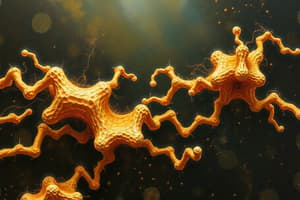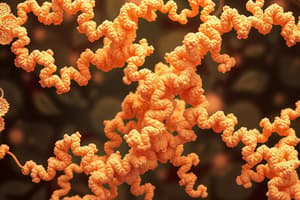Podcast
Questions and Answers
What is the difference between a peptide and a protein?
What is the difference between a peptide and a protein?
- A peptide consists of amino acids that form secondary structures.
- Proteins and peptides do not differ.
- Peptides are made up of linear amino acid chains. (correct)
- A protein is different in that it contains amino acids whereas a peptide does not.
Beta sheets adopt_______
Beta sheets adopt_______
- All of the answers are correct (correct)
- coiled formations.
- antiparallel orientations.
- parellel conformations.
A protein can interact with water and lipds because__________
A protein can interact with water and lipds because__________
- it has polar and hydrophobic amino acids. (correct)
- it forms weak non-colavent interactions.
- the weak non-covalent interactions are strong enough to endure interactions with both water and lipids.
The figure below shows a depiction of an antibody. Which label correctly identifies the region(s) of the antibody that contains variable amino acids for binding of a specific antigen?
The figure below shows a depiction of an antibody. Which label correctly identifies the region(s) of the antibody that contains variable amino acids for binding of a specific antigen?
A glycoprotein ______.
A glycoprotein ______.
The first amino acid to be discovered was______________.
The first amino acid to be discovered was______________.
Which of the following levels of protein structure involves the interaction of more than one protein into a multi-complex structure?
Which of the following levels of protein structure involves the interaction of more than one protein into a multi-complex structure?
Hydrogen bonding between NH and C=O groups of every 4th amino acid within the polypeptide backbone results in which type of folding pattern?
Hydrogen bonding between NH and C=O groups of every 4th amino acid within the polypeptide backbone results in which type of folding pattern?
The variable region on the surface of an antibody interacts specifically with an antigen through____.
The variable region on the surface of an antibody interacts specifically with an antigen through____.
Which of the following represents secondary structures in a protein?
Which of the following represents secondary structures in a protein?
Study Notes
Peptides and Proteins
- A peptide is a short chain of amino acids, whereas a protein is a long chain of amino acids.
Protein Structure
- Beta sheets adopt a pleated sheet conformation.
Protein Interactions
- A protein can interact with water and lipids because of its hydrophilic (water-loving) and hydrophobic (water-fearing) regions.
Antibody Structure
- The variable region of an antibody contains variable amino acids for binding of a specific antigen.
- The correct label for this region is the Fab (fragment, antigen-binding) region.
History of Amino Acid Discovery
- The first amino acid to be discovered was asparagine.
Protein-Protein Interactions
- Quaternary structure involves the interaction of more than one protein into a multi-complex structure.
Hydrogen Bonding and Folding
- Hydrogen bonding between NH and C=O groups of every 4th amino acid within the polypeptide backbone results in an alpha-helix folding pattern.
Antibody-Antigen Interactions
- The variable region on the surface of an antibody interacts specifically with an antigen through complementary shapes and chemical properties.
Secondary Structure
- Alpha helix and beta sheets represent secondary structures in a protein.
Studying That Suits You
Use AI to generate personalized quizzes and flashcards to suit your learning preferences.
Description
Learn about the structure and properties of peptides, proteins, and antibodies, including their interactions and functions.



